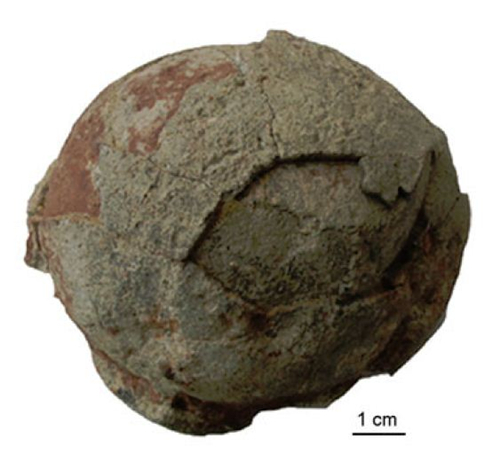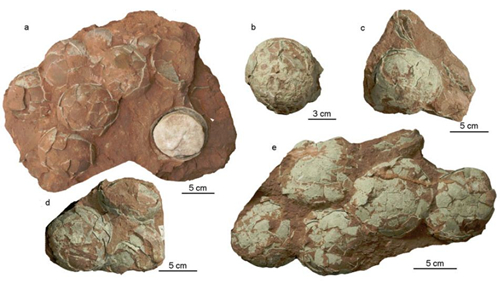| Location: Home > Research > Research Progress |
| New Oofamily of Dinosaur Egg Found From the Upper Cretaceous of Tiantai Basin, Zhejiang Province |
|
Paleontologists from the Institute of Vertebrate Paleontology and Paleoanthropology (IVPP), Chinese Academy of Sciences, found more than a dozen eggs from the lower member of the Late Cretaceous Chichengshan Formation in Shuangtang, Qiaoxia and Brewery in the Tiantai Basin. These eggs have a distinctive eggshell microstructure not seen in other types of dinosaur egg. Based on both egg macrostructure and eggshell microstructure characteristics, researchers established one new oofamily, two new oogenera, one new oospecies, and one new binomial combination oospecies, according to a paper published in the October 2012 issue of the Journal of Chinese Science Bulletin (vol.57, 28-29). The Upper Cretaceous strata of the Tiantai Basin consist of the Laijia Formation and the overlying Chichengshan Formation. The Laijia Formation is composed of lacustrine sediments such as red silty mudstones and granule conglomerates, with many layers of interbedded laminated tuffs. The Chichengshan Formation can be subdivided into two members. The lower member, which has yielded a large number of dinosaur eggs and bones, is composed of red conglomerates, sandstones, and silty mudstones with interbedded tuffs; whereas the upper member is composed of red conglomerates and sandstones interbedded with muddy siltstones. SIMS U-Pb zircon dating of the Laijia and Chichengshan formations indicated an age of 98–91 Ma, corresponding to the early Late Cretaceous (Cenomanian-Turonian). These small spheroid or nearly spheroid eggs are irregularly arranged in the nest. Eggshell thickness, 2.4–4.0 mm. Outer surface of the eggshell is coarsely decorated. Cone layer is thin with 0.18–0.25 mm thick, about 1/20–1/4 of eggshell thickness. Three distinct zones of the columnar layer are observable: (1) Horizontal growth lines develop in the inner zone, (2) Light and dark bands with varying thickness and lengths develop in the medial zone, (3) Secondary eggshell units are loosely arranged in the outer zone. The pore cannel is irregular. With occurrence of numerous, tiny secondary eggshell units within the pore canals, three distinct zones of the columnar layer are significantly different from other dinosaur egg types found in the world. Thus, they are considered to be a new oofamily, Stalicoolithidae. “The newly discovered dinosaur eggs are very important for understanding the composition of the Tiantai dinosaur eggs oofauna and providing new materials to study the eggshell formation and evolution of the dinosaur eggs in the Cretaceous”, said corresponding author WANG Xiaolin of the IVPP. “Our re-examination of the holotype of Shixingoolithus erbeni from the Upper Cretaceous Pingling Formation, Guangdong Province, indicatess that it was erroneously attributed to Spheroolithidae, and should be transferred to stalicoolithid. Stalicoolthids represents a new model of dinosaur eggshell and thus sheds new light on the formation and evolution of amniotic eggshells”, said first author WANG Qiang of the IVPP. This work was supported by the National Natural Science Foundation of China, the National Science Fund for Distinguished Young Scholars, the National Key Basic Research Program of China, and the Key Laboratory of Evolutionary Systematics of Vertebrates, IVPP, CAS.
Fig.1 Stalicoolithus shifengensis oogen. et oosp. nov. holotype (TTM29). (Image by WANG Qiang)
Fig.2 Coralloidoolithus shizuiwanensis oogen. et comb. nov.. a, an incomplete nest consists of nine dinosaur eggs (TTM2); b, one nearly complete dinosaur egg (IVPP V16966.3); c, one nearly complete and two broken dinosaur eggs (IVPP V16966.2); d, one nearly complete and two broken eggs (V16966.4); e, an incomplete nest consists of five complete and one fragmentary dinosaur eggs (V16966.1). (Image by WANG Qiang)
|

